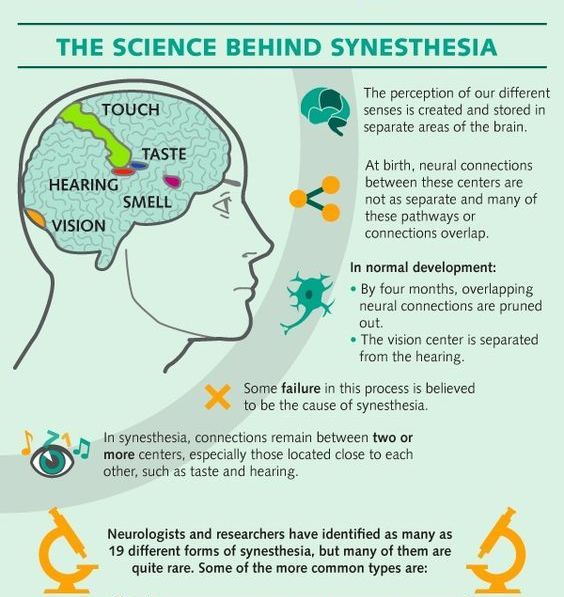Imagine seeing numbers and letters as colors even though they are printed in black. Imagine music and voices triggering a swirl of moving coloured shapes, in which words and names fill your mouth with unusual flavors. This isn’t upcoming cutting edge technology. This has always been possible. We’re talking about synesthesia and those who experience it – synesthetes.
Synesthetes, who experience a blending of senses such as seeing colors when hearing music, may have advantages as musicians. Their unique sensory experiences, as seen in artists like Pharrell Williams and Lorde, can enhance musical creativity and perception, potentially making them better musicians
What is Synesthesia?
Related: Sysnesthesia is Biological Magic
Synesthesia is a neurological phenomenon that links two or more senses simultaneously. It is found in 4% of the population, and involves the mixing of any of our senses. A person with synesthesia might not only hear a voice but also see it, taste it or feel it as a physical touch. There are about 19 different types of synesthesia. The word shares its root with anesthesia – which means no sensation, while synesthesia means joined sensation.
One sort of synesthesia – involveing colored hearing, gives one a 50% chance of having a second, third or fourth type. Synesthesia is a trait, like having a blue colored eye, rather than a disorder. Synesthetes inherit a biological propensity for hyper-connecting brain neurons. A single nucleotide change in the sequence of one’s DNA alters your perception. Synesthesia thus provides a path to understand subjective difference on how two people can perceive the same thing differently.

How people with synesthesia perceive music?
Related: How, or Why Does Trance Music Work?
People with synesthesia experience the ordinary world in an … extraordinary way. The ability to induce colours in the sound heard is called chromesthesia, or sound-to-color-synesthesia. People with chromesthesia are more inclined to play a musical instrument. For them the sound of music may be a visual spectacle of dancing shapes, colours, and textures. Synesthesia makes music a visual experience.
A specific musical note of the scale will trigger a specific colour. Whenever a musical instrument is played, a synesthete will have a visual experience of colour which helps her to tune her instrument. Synesthetes tend to have a better memory because they always have two associations with everything.
Some Famous Musician Synesthetes
Pharrell Williams
Williams claims that for every colour, he perceives a musical note. He calls synesthesia a gift to him and “couldn’t possibly compose music without it”. For Pharrell, his international hit Happy is yellow, with accents of mustard and sherbet orange.
Kanye West
Kanye sees pianos as blue, snares as white and bass lines as dark brown and purple. And, credits his artistic genius to synesthesia. “Everything I sonically make is a painting. I see it. I see the importance and the value of everyone being able to experience a more beautiful life”, he adds.
Charli XCX
This young female pop icon too sees music in colours. She loves the music in pink, black, purple or red but hates the one in green, yellow or brown colour as per her perception. For her, a warm bass sound is deep purple and EDM is green. Associating sound with different colour palettes helps her with songwriting and music videos.
Lorde
The 20-year-old singer and songwriter say her songs are a creation of her imagination, synesthesia, and collaborators. She aims to colour code her songs and map out the hues until the desired rhythm, emotion and texture is achieved. She says, “It’s about getting the actual thing to sound like what I’ve been seeing.”
Unwardly we are all synesthetes, perhaps outwardly unaware of the perceptual couplings happening all the time. Cross-talk in the brain is the rule, not the exception.